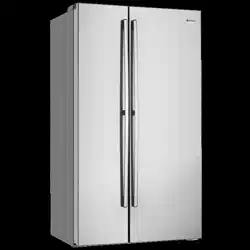Documents: Go to download!
User Manual
- User Manual - (English)
- installation guide - (English)
- spec sheet - (English)
- Refrigerator features
- USING YOUR REFRIGERATOR
- ABOUT THE USER INTERFACE
- CLEANING YOUR REFRIGERATOR
- TROUBLESHOOTING
Table of contents
USER MANUAL Side by Side Refrigerator
Refrigerator features
NON ICE AND WATER FEATURES

Features may vary depending on model. Not all models will have features listed.
Control panel
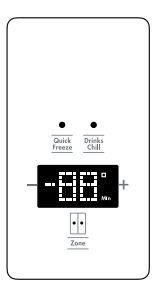
From this panel you can control the temperature of the refrigerator and freezer compartments as well as setting the quick freeze and drinks chill functions. For further information on how to use this feature refer to the section “About the User Interface”.
ICE AND WATER FEATURES
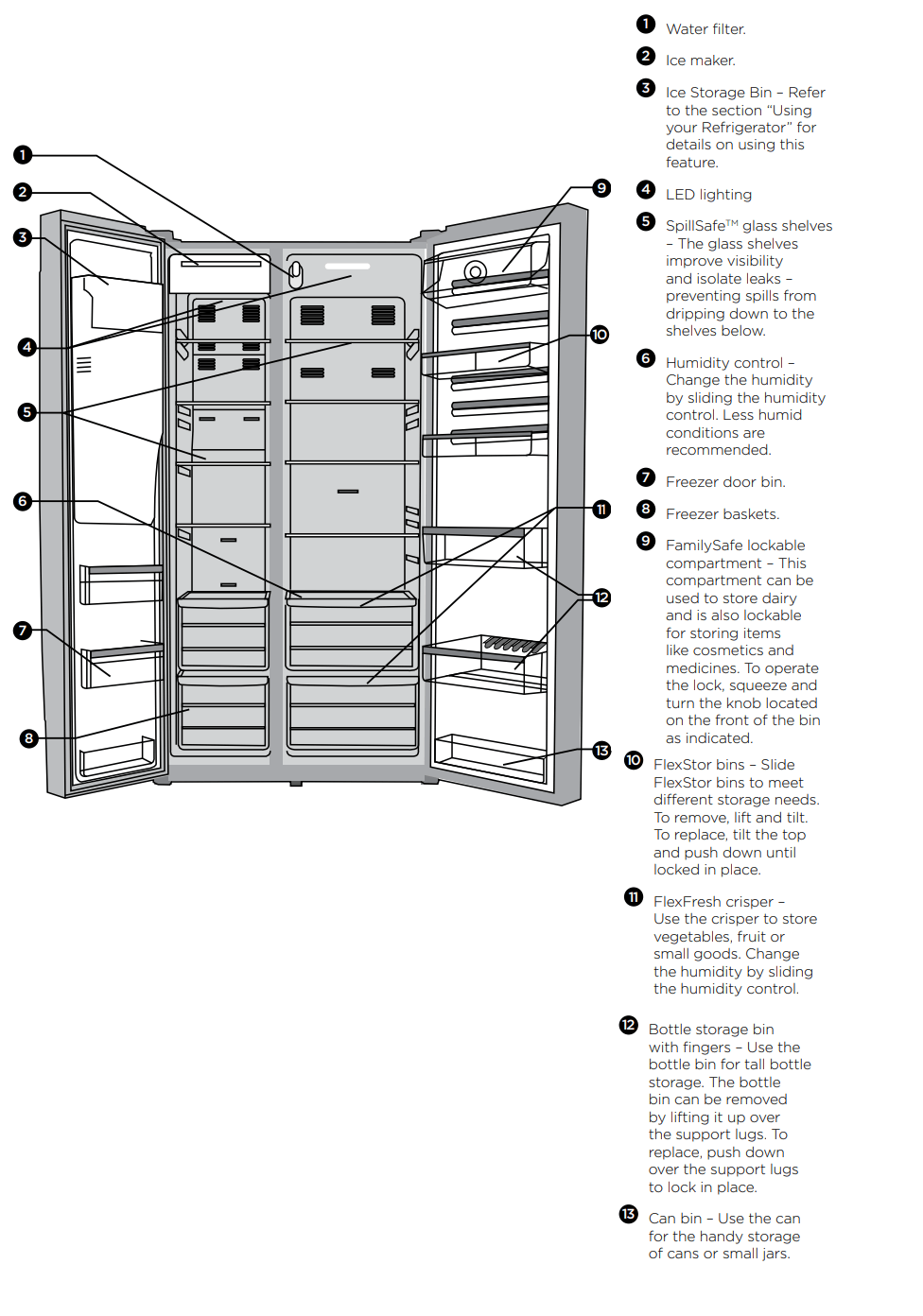
Features may vary depending on model. Not all models will have features listed.
Control panel
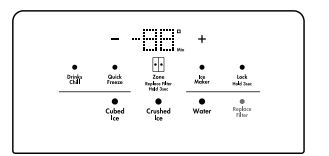
From this panel you can control the temperature of the refrigerator and freezer compartments as well as setting the quick freeze and all the icemaker functions. For further information on how to use this feature refer to the section “About the User Interface”.
USING YOUR REFRIGERATOR
Refrigerators work by transferring heat from the food inside to the outside air. This operation makes the back and sides of the refrigerator feel warm or even hot particularly at start-up and on warm days – this is normal.
Avoid placing food against the air vents in the refrigerator as it affects efficient circulation. If the door is opened frequently, a light frosting will occasionally occur on the freezer’s interior. This is normal and will clear after a few days. If the freezer door is accidentally kept open, a heavy frost will coat the inside walls and should be removed.
Your new refrigerator uses a high-speed compressor, along with other energy-efficient components, which may make unusual sounds and be more noticeable at night and quieter times. These sounds simply indicate your refrigerator is working how it should. They include:
- Compressor running noises;
- Air movement noise from the small fan motor;
- A gurgling sound, similar to water boiling;
- A popping noise, heard during automatic defrosting; and
- A clicking noise, prior to compressor start-up.
Further details can be found in the Troubleshooting Guide.
Temperature Sensors
Avoid loading food against your freezer temperature sensor.
Doing so may adversely affect freezer temperatures. If warm food is inadvertently loaded against the sensor, it may also set off the freezer temperature alarm for up to 50 minutes after the food is loaded against the sensor.
Twist ice and Serve
To use, remove the tray, fill with water and place back in the freezer.
Once ice has formed (approximately 3 hours) simply twist the knob at the front clockwise until the ice drops into the bin below.
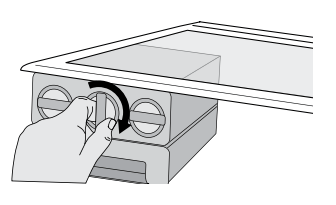
Ice and water dispenser features
The ice and water dispenser conveniently dispenses cool, filtered water and ice cubes or crushed ice.
To operate the ice dispenser, select an ice option using the electronic display and press a glass against the dispensing paddle.
To stop dispensing ice, pull the glass away from the dispensing paddle. Remove the glass from the dispenser paddle when it is approximately half full.
Ice already in the chute may cause the glass to overflow or back up into the chute and cause a blockage (refer to troubleshooting guide on how to unblock the ice chute).
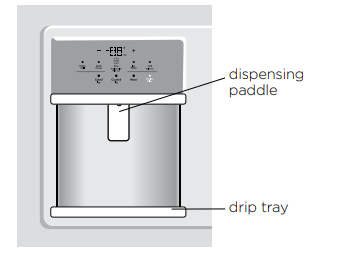
To operate the water dispenser, select the water option on the electronic display, press a glass against the dispensing paddle.
To stop dispensing water, pull the glass away from the water dispensing paddle. As the ice and water cut-off is not instant, leave glass under the dispenser until the ice and water has completely stopped to avoid spills.
A drip tray located at the base of the dispenser (see diagram above) will catch small spills and allow them to evaporate.
Opening the freezer door will de-activate the ice dispenser.
USING YOUR REFRIGERATOR
Bottle filling function
The bottle filling function facilitates the flow of water directly into the mouth of a bottle, minimising splashing and spillage. Water flows from the water dispensing nozzle located on the underside of the ice and water dispenser.
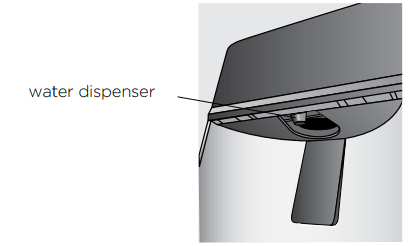
To use this function, place the mouth of the bottle over the water dispensing nozzle.
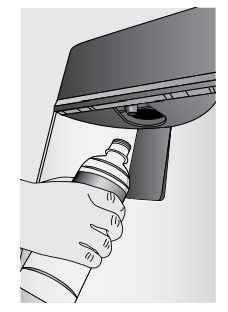
Once the mouth of the bottle is completely over the water dispensing nozzle (see diagram below) gently push bottle up to dispense water and fill bottle. Once the bottle is full, remove the bottle and the flow of water will stop automatically
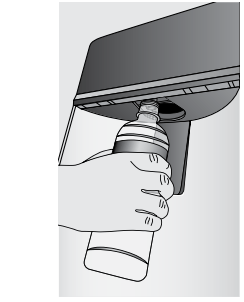
Controlling the temperature
The default temperature for the refrigerator is 3°C and -18°C for the freezer. If you want to change the temperature, follow the instructions on the following pages.
Make only small adjustments and wait 24 hours to see if it’s correct. Checking the softness of ice cream is a good indication of whether your freezer is at the correct temperature, while feeling the coldness of water kept in your refrigerator is a good way of checking the temperature of the food compartment.
NOTE: The set temperature for the refrigerator is an average temperature for the whole refrigerator cabinet. Temperatures inside each compartment may vary depending on how much food you store and where you place it. High or low temperature may also affect the actual temperature inside the refrigerator
Door alarm
Your new appliance is fitted with a door alarm. This alarm will sound if the refrigerator or freezer door is left open for longer than 3 minutes, To silence the alarm, check for any obstructions preventing the door from closing and remove or simply close the door.
ABOUT THE USER INTERFACE
Controls – Non ice and water refrigerator models
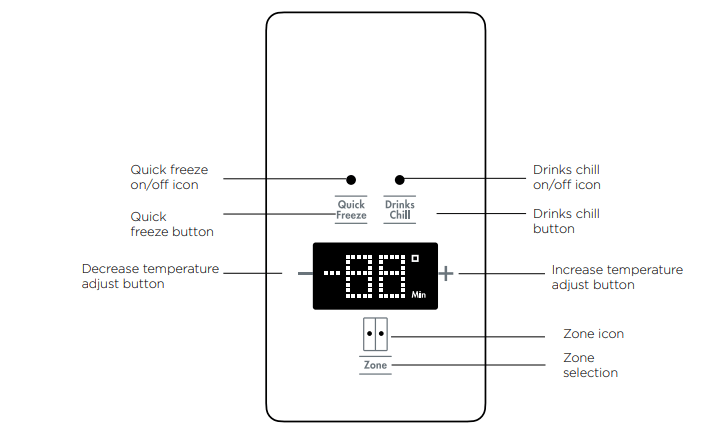
|
DESCRIPTION |
OPERATION / PRIMARY FUNCTION |
|
Quick Freeze on/ off icon |
|
|
Quick Freeze button |
Use the Quick Freeze function when you acid a large amount of food to the freezer compartment.
|
|
Drinks Chill on/off icon |
|
|
Drinks Chill button |
Sets a timer for between 1 and 30 minutes as a reminder for when drinks are placed in the freezer for quick chill.
Do not leave the bottle inside the freezer longer than the time needed for chilling. |
|
Digital display |
|
|
Temperature adjust buttons |
|
|
Zone Icon |
|
|
Zone select button |
|
IMPORTANT If you want to change the temperature, remember to make only small adjustments and wait 24 hours to see if it’s correct.
Controls – ice and water model
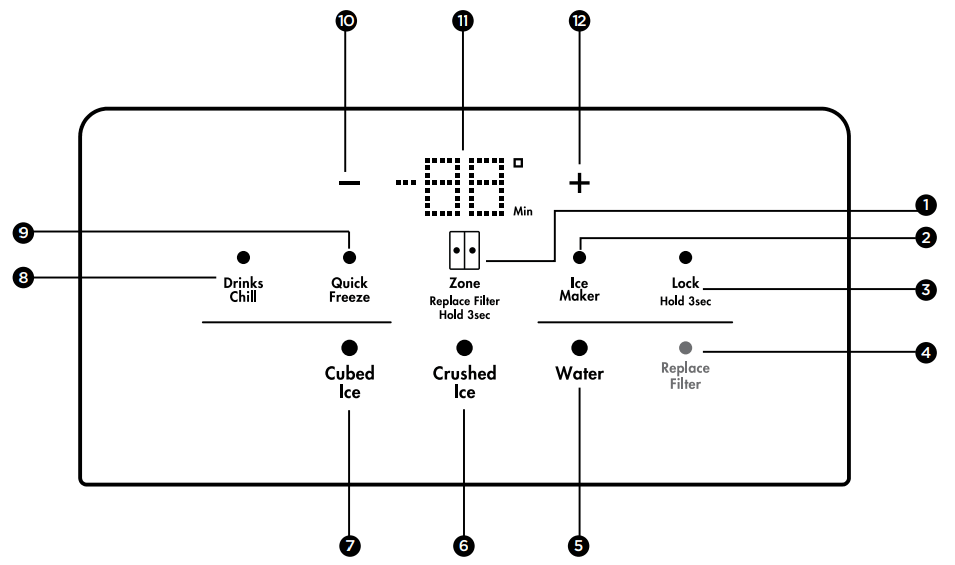
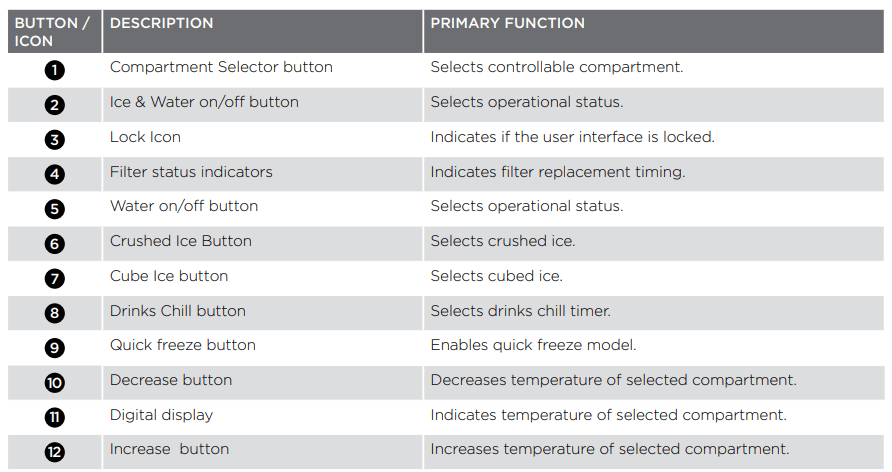
IMPORTANT The factory default settings for the refrigerator is “3°” and “-18°C” for the freezer. If you want to change the temperature, remember to make only small adjustments and wait 24 hours to see if it’s correct.
FUNCTIONS OF THE USER INTERFACE
ice and water model
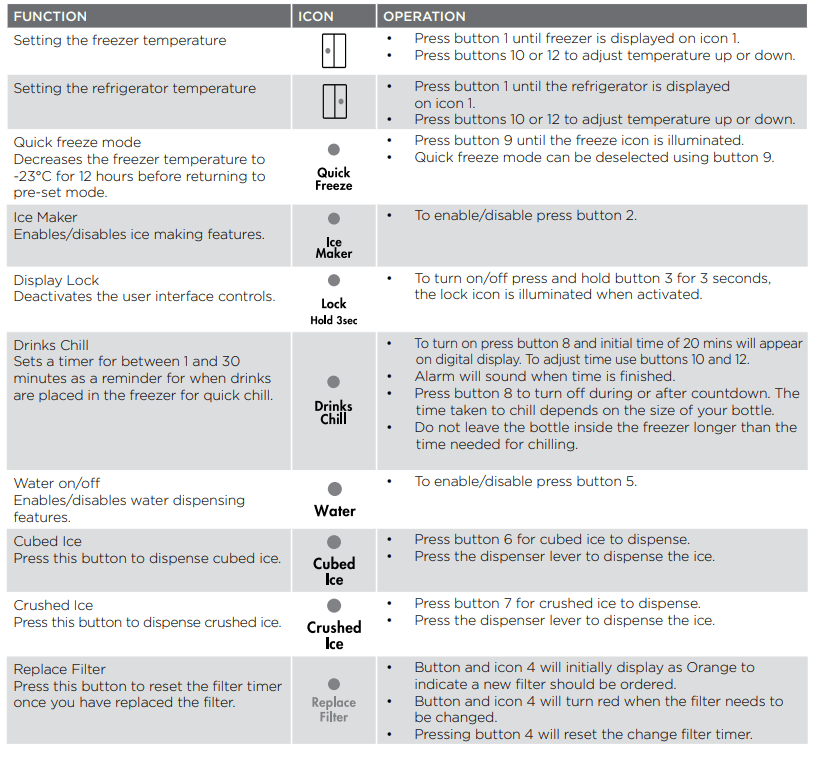
CLEANING YOUR REFRIGERATOR
Doors and exterior (white and silver):
You should only clean the doors with lukewarm soapy water and a soft cloth.
Stainless Steel:
Your stainless steel refrigerator is manufactured from mark-resistant stainless steel. This stainless steel has a special advanced protective coating that eases the removal of marks such as fingerprints and water spots. To keep its appearance, clean it regularly with lukewarm soapy water and a soft cloth.
Interior
Clean the inside of your refrigerator regularly with a soft cloth, unscented mild soap and lukewarm water. Thoroughly dry all surfaces and removable parts and avoid getting water on the controls. Replace removable parts, plug power cord in and switch the power on before returning the food.
Door seals
Always keep door seals clean by washing them with a mild detergent and warm water, followed by a thorough drying. Sticky food and drink can cause seals to stick to the cabinet and tear when you open the door.
Never use hot water, solvents, commercial kitchen cleaners, aerosol cleaners, metal polishes, caustic or abrasive cleaners, or scourers to clean your refrigerator. Many commercially available cleaning products and detergents contain solvents that will damage your refrigerator. Use only a soft cloth with an unscented mild soap and lukewarm water.
Switching off your refrigerator
If you switch off your refrigerator for an extended period, follow these steps to reduce the chances of mould:
- Remove all food.
- Remove the power plug from the power point.
- Thoroughly clean and dry the interior.
- Ensure that all the doors are wedged open slightly for air circulation.
FOOD STORAGE GUIDE
|
CATEGORY |
PRODUCT |
REFRIGERATOR |
FREEZER |
STORAGE TIPS |
| Meat | Sausages and Mince | 1-2 Days | 2-3 Months | Keep cold meat at the back of the refrigerator where it is coldest. |
| Chops and Steak | 3-4 Days | 4-6 Months | ||
| Colei Meats | 3-5 Days | 4-6 Months | Plastic can cause meat to sweat if stored in refrigerator for more than a clay. | |
| Cuts for roasting | 3-5 Days | 12 Months | Cuts for roasting can take up to 48 hours to defrost properly, transfer frozen cuts to the refrigerator 2 clays before use. | |
| Poultry | Chicken | 1-2 Days | 2 Months | If poultry takes on a smell or colour you are unsure about it is best to throw it out. |
| Roast Chicken | 3-5 Days | 12 Months | ||
| Eggs | 6 Weeks | Not Suitable | Whole eggs are not suitable for freezing, slightly beaten eggs may be frozen for four months. | |
| Seafood | Whole fish and fillets | 2-3 Days | 2 Months | Store in an airtight container or foil. |
| Lobster and crabs | 1-2 Days | 2 Months | Never freeze prawns in salty water as this will dehydrate the flesh. | |
| Prawns | 1-2 Days | 2 Months | ||
| Dairy | Milk | Until Expiry Date | Not Suitable | If dairy takes on a smell or colour and you are unsure about it, it is best to throw it out. |
| Yoghurt | 7-10 Days | Not Suitable | ||
| Hard Cheeses | 2 Weeks - 2 Months | 2 Months (Grated) | ||
| Soft Cheeses | 1-2 Weeks | Not Suitable | Depending on the variety hard cheese can last from 2 weeks to 2 months. | |
| Butter | 8 Weeks | 12 Months | ||
| Fruit & Vegetables | Every fruit and vegetable has a different shelf life. | 8-12 Months | Keep vegetables in the crisper and away from the air vents to avoid freezing. | |
| When freezing chop and blanch in small portions. | ||||
| Some stay fresh for a couple of days e.g beans, others can last for a couple of months e.g. onions. | If you wash fruit and vegetables before storing them make sure they are dry or wrap in absorbent paper before storing in the refrigerator as this can make them susceptible to rotting. | |||
| Try to keep fruit and vegetables separated as fruits that give off high levels of ethylene (the ripening agent) can prematurely ripen and spoil surrounding vegetables. | ||||
| Left Overs | Homemade meals | 3-4 Days | 2-6 Months | Store in sealed container. |
| Freeze meals in small portion sizes to limit wastage. | ||||
IMPORTANT: Please note, use this information as a guide only, actual storage times will vary depending on how you use your refrigerator, climatic conditions and the freshness of the food. Food should not be left uncovered in the refrigerator.
TROUBLESHOOTING
APPLIANCE DOES NOT OPERATE AT DESIRED TEMPERATURE
In a modern frost free refrigerator/freezer, cold air is circulated around the various compartments through air vents using a high efficiency fan.
|
CONCERN |
WHAT TO DO |
|---|---|
| Refrigerator is too warm |
Ensure food is allowed to cool before placing inside the refrigerator. Ensure the appliance is set up as per instructions on page 11. Ensure that contents are not obstructing the cooling vents. Ensure the door is not held open or is being opened too frequently |
| Freezer is too warm |
Adjust temperature to a colder setting. Ensure food is allowed to cool before placing inside the freezer. Ensure the appliance is set up as per instructions on page 11. Ensure that contents are not obstructing the cooling vents. Ensure the door is not held open or is being opened too frequently |
| Food is freezing in the refrigerator |
Adjust temperature to a warmer setting. Ensure that fruit and vegetables are stored in the crisper. Items with a high water content should not be placed near the cooling vents. |
| Unable to change temperature settings |
Refer to function guide in the "User Interface" section. Ensure that user interface is in "awake" mode before trying to adjust temperature settings. |
APPLIANCE NOISE
Your new refrigerator may make sounds that your old one didn’t make. Because the sounds are new to you, you might be concerned about them. Most of the new sounds are normal. Hard surfaces, like the floor, walls and cabinets, can make the sounds seem louder than they actually are. The following describes the kinds of sounds and what may be making them.
|
CONCERN |
WHAT TO DO |
|---|---|
| Motor noise (compressor) |
Nothing. This is normal as your new refrigerator uses a high-speed compressor which switches on and off during operation. Note that the compressor noise may seem louder at the start of the on cycle. |
| A clicking noise heard just before the compressor starts | Nothing. This is normal as your new refrigerator has an automatic switching action of the temperature control, turning the compressor on and off |
| Occcasional gurgling, similar to water boiling. | Nothing. As each cycle ends, you may hear a gurgling sound due to the refrigerant flowing in your refrigerator system |
| Airflow noise. | Nothing, this is normal as your new refrigerator uses high efficiency fans to circulate air. |
| Rattling and other noises. |
Ensure that the cabinet is level and stable, refer to Installation Instructions on page 6. Check the surrounds of the appliance to ensure there is nothing touching or placed on top of the appliance. Ensure that contents of the appliance are not placed in such a way that they are vibrating (such as bottles). |
CRISPER OPERATION
|
CONCERN |
WHAT TO DO |
|---|---|
| Excess moisture build up in crisper |
Ensure that the crisper is not over packed Adjust crisper humidity slides. |
| It is normal for there to be some moisture and humidity in the crisper bin. | |
| Crisper bin can not be removed |
If crisper bin interferes with the door bins, remove door bins before removing crisper. Position cabinet so that the door can be fully opened |
| Freezing items in the crisper | Adjust temperature to a warmer setting. |
REFRIGERATOR OPERATION
|
CONCERN |
WHAT TO DO |
|---|---|
|
Appliance will not run It is normal for the freezer fan not to operate during the automatic defrost cycle, or for a short time after the appliance is switched on. |
Ensure that the cord is plugged into a live power outlet and outlet is switched on. Ensure that the household circuit breaker has not tripped or that the fuse has not blown. The appliance maybe in defrost mode, check again in half an hour |
|
Compressor motor seems to run too long At normal room temperatures, expect your motor to run about 40% to 80% of the time. Under warmer conditions, expect it to run even more often. |
Ensure that the doors are not held open. Check that large amounts of warm food have not just been placed inside the appliance. Note that the appliance will run more than normal just after you install it or when adjusting to temperature setting changes. |
|
The exterior of the appliance is warm or hot to touch This is normal because the appliance transfers heat from the inside out through the outer panels and the divider between the doors. |
Ensure the appliance has the external clearances recommended in the section “Installing your new appliance”. The exterior of the cabinet will be much warmer on warmer days it may even feel hot to touch, as the appliance is working harder. |
|
User interface will not respond To ensure settings are not accidentally changed the user interface will go into sleep mode when not in use. Press any button to wake user interface |
Check that the user interface is in awake mode, refer to section “User interface”. Check that the user interface is not locked, refer to section “User interface”. If the user interface is frozen turn the appliance off for five minutes for the memory to clear, then turn back on. |
| Alarms Sounding |
Check that all doors are fully closed. Ensure that the over temperature alarm is not being activated by hot food placed in the freezer. Check if the drinks timer has ended, refer control instructions. Check if the Filter Replacement alert is activated, refer control instructions. (I&W models only) |
| Frost build up |
Check that all doors are fully closed. Ensure that the doors are not opened too often. Ensure that the return air vents are not blocked with packaging. Ensure the seals are clean and not obstructed. |
| Odours |
The interior may need cleaning, refer to cleaning guide. Ensure that food is stored correctly as some food, containers and wrapping can produce odours. Check appliance for old or unusual food. |
|
Lights not working The LED lighting is designed to turn on gradually. |
Ensure that the cord is plugged into a live power outlet and outlet is switched on. Ensure that the household circuit breaker has not tripped or that the fuse has not blown. Check the appliance features section to determine lighting configuration for your model. |
DOOR OPERATION
|
CONCERN |
WHAT TO DO |
|---|---|
| Self close not working. |
Check if your appliance has self closing hinges as not all models do. It indicates that the appliance needs to be tilted backwards a little further. Refer to section “Installing your new appliance”. |
| Door not sealing properly |
Ensure there is nothing that is preventing the door from closing such as appliance contents or items placed near the appliance. Ensure that the crisper/freezer bin is closed completely and that nothing is preventing it from closing. Ensure the appliance is set up as per recommendations. |
| Door difficult to open and close | If the door is difficult to open just after you have closed it this is due to the pressure equalising, the door will open normally after a few minutes. |
AUTOMATIC ICE MAKER
|
PROBLEM |
POSSIBLE CAUSES |
SOLUTION |
|---|---|---|
| The ice maker is not making any ice |
|
|
|
|
|
|
|
|
|
|
|
|
|
|
| The ice-maker is not making enough ice |
|
|
|
|
|
|
|
|
|
|
|
| Ice cubes are too small or too big |
|
|
|
|
|
|
|
|
|
||
| The ice has a bad odour and taste |
|
|
|
||
|
|
|
|
|
ICE DISPENSER
|
PROBLEM |
POSSIBLE CAUSES |
SOLUTION |
|---|---|---|
| The dispenser will not dispense ice |
|
|
|
||
|
||
|
||
| The ice dispenser is jammed |
|
|
|
|
|
|
||
| Water leaking from ice dispenser |
|
|
|
|
|
| The flap on the ice dispenser does not close properly |
|
|
If you still require service
If you have a problem, and the problem persists after you have made the checks mentioned, contact your nearest Electrolux approved Service Centre or the dealer you bought the refrigerator from. Be ready to quote the model number, the 9-digit PNC and 8-digit serial number, which is stated on the label inside the refrigerator compartment
See other models: WVE645S WHG640SA WTB3400WG WRCG933SB WVG655W
